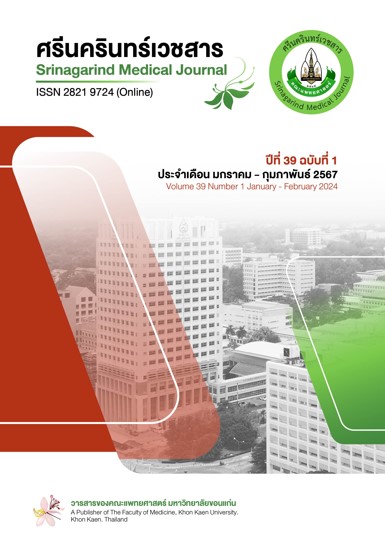Asiatic Acid Alleviates Diabetic Kidney Injury Through Suppression of Renal Oxidative Stress
Keywords:
diabetic kidney injury, renal oxidative stress, asiatic acidAbstract
Background and Objective: Diabetes mellitus is a well-established risk factor for kidney injury. Chronic hyperglycemia in diabetes can potentially impair kidney function and structural changes through promotion of oxidative stress. The present study aimed to investigate the effect of asiatic acid (AA), an antioxidant on kidney injury and oxidative stress in diabetic rats.
Methods: Eight-week-old male Wistar rats weighing between 180 to 200 grams were induced to have type 2 diabetes by a single intraperitoneal injection of streptozotocin (STZ; 55 mg/kg) and nicotinamide (NA; 110 mg/kg). AA at doses of 10 or 20 mg/kg/day was administered intragastrically for 8 weeks. Metabolic changes in these rats were monitored during the experimental period. At the end of the experiment, kidney tissues and blood were collected from all rats for further experiments.
Results: Diabetic rats exhibited hyperglycemia, impaired insulin secretion, insulin insensitivity, an increased rate of kidney superoxide anion production. Moreover, diabetic rats also exhibited glomerular hypertrophy and glomerular ultrastructural changes. Treatment with AA, especially at a dose of 20 mg/kg/day, significantly attenuated insulin resistance, and kidney malondialdehyde (MDA) levels. AA also exerted a beneficial effect on renal protection by reducing glomerular hypertrophy and thickening of glomerular basement membranes.
Conclusions: AA alleviates kidney injury in diabetic rats through its glucose-lowering effect and antioxidant activity. These findings suggest the beneficial effects of AA as a potent antioxidant that could help prevent the progression of diabetic kidney complications.
References
Chawla A, Chawla R, Jaggi S. Microvasular and macrovascular complications in diabetes mellitus: Distinct or continuum? Indian J Endocrinol Metab 2016;20(4):546-51. doi:10.4103/2230-8210.183480.
Lim A. Diabetic nephropathy - complications and treatment. Int J Nephrol Renovasc Dis 2014;11(7):361-81. doi:10.2147/IJNRD.S40172.
Liu J, He T, Lu Q, Shang J, Sun H, Zhang L. Asiatic acid preserves beta cell mass and mitigates hyperglycemia in streptozocin-induced diabetic rats. Diabetes Metab Res Rev. 2010;26(6):448-54. doi:10.3390/ijms242417603.
Wang X, Lu Q, Yu DS, Chen YP, Shang J, Zhang LY, et al. Asiatic acid mitigates hyperglycemia and reduces islet fibrosis in Goto-Kakizaki rat, a spontaneous type 2 diabetic animal model. Chin J Nat Med 2015;13(7):529-34. doi:10.1016/S1875-5364(15)30047-9.
Chao KC, Chen SH, Chang CC, Lee YC, Wang CM, Chang JS. Effects of ferric citrate supplementation on advanced glycation end products in a rat model of streptozotocin/nicotinamide-induced diabetes. Mol Nutr Food Res 2017;61(5). doi:10.1002/mnfr.201600753
Kumashiro N, Tamura Y, Uchida T, Ogihara T, Fujitani Y, Hirose T, et al. Impact of oxidative stress and peroxisome proliferator-activated receptor gamma coactivator-1alpha in hepatic insulin resistance. Diabetes 2008;57(8):2083-91. doi:10.2337/db08-0144
Walke PB, Bansode SB, More NP, Chaurasiya AH, Joshi RS, Kulkarni MJ. Molecular investigation of glycated insulin-induced insulin resistance via insulin signaling and AGE-RAGE axis. Biochim Biophys Acta Mol Basis Dis 2021;1867(2):166029. doi:10.1016/j.bbadis.2020.166029
Kalidhindi S, Uddandrao VVS, Sasikumar V, Raveendran N, Ganapathy S. Mitigating perspectives of asiatic acid in the renal derangements of streptozotocin-nicotinamide induced diabetic rats. Cardiovasc Hematol Agents Med Chem 2020;18(1):37-44. doi:10.2174/1871525718666200131121419.
Ramachandran V, Saravanan R, Senthilraja P. Antidiabetic and antihyperlipidemic activity of asiatic acid in diabetic rats, role of HMG CoA: in vivo and in silico approaches. Phytomedicine. 2014;21(3):225-32. doi: 10.1016/j.phymed.2013.08.027.
Kumari S, Deori M, Elancheran R, Kotoky J, Devi R. In vitro and in vivo antioxidant, anti-hyperlipidemic properties and chemical characterization of centella asiatica (l.) extract. Front Pharmacol 2016;7:400. doi: 10.3390/molecules26071907.
Wang Y, Jin M, Cheng CK, Li Q. Tubular injury in diabetic kidney disease: molecular mechanisms and potential therapeutic perspectives. Front Endocrinol (Lausanne) 2023;14:1238927. doi:10.3389/fendo.2023.1238927.
Song S, Hu T, Shi X, Jin Y, Liu S, Li X, et al. ER stress-perturbed intracellular protein o-glcnacylation aggravates podocyte injury in diabetes nephropathy. Int J Mol Sci 2023;24(24). doi: 10.3390/ijms242417603.
Sun HJ, Wu ZY, Cao L, Zhu MY, Liu TT, Guo L, et al. Hydrogen sulfide: recent progression and perspectives for the treatment of diabetic nephropathy. Molecules 2019;24(15). doi:10.3390/molecules24152857.
Sangartit W, Ha KB, Lee ES, Kim HM, Kukongviriyapan U, Lee EY, Chung CH. Tetrahydrocurcumin ameliorates kidney injury and high systolic blood pressure in high-fat diet-induced type 2 diabetic mice. endocrinol metab (seoul) 2021;36(4):810-22. doi:10.3803/EnM.2021.988.
Hayashi T, Takai S, Yamashita C. Impact of the renin-angiotensin-aldosterone-system on cardiovascular and renal complications in diabetes mellitus. Curr Vasc Pharmacol 2010;8(2):189-97. doi: 10.2174/157016110790886947.
Liang Y, Zeng X, Guo J, Liu H, He B, Lai R, et al. Scopoletin and umbelliferone from Cortex Mori as protective agents in high glucose-induced mesangial cell as in vitro model of diabetic glomerulosclerosis. Chin J Physiol 2021;64(3):150-58. doi:10.4103/cjp.cjp_9_21.
Yoon JJ, Lee YJ, Lee SM, Kang DG, Lee HS. Oryeongsan suppressed high glucose-induced mesangial fibrosis. BMC Complement Altern Med 2015; 30(15): 001-11. doi: 10.1186/s12906-015-0542-6.
Abu Bakar MH, Shariff KA, Tan JS, Lee LK. Celastrol attenuates inflammatory responses in adipose tissues and improves skeletal muscle mitochondrial functions in high fat diet-induced obese rats via upregulation of AMPK/SIRT1 signaling pathways. Eur J Pharmacol 2020;52(883). doi: 10.1016/j.ejphar.2020.173371.
Downloads
Published
How to Cite
Issue
Section
License
Copyright (c) 2024 Srinagarind Medical Journal

This work is licensed under a Creative Commons Attribution-NonCommercial-NoDerivatives 4.0 International License.




